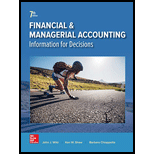
1.
To identify: Total amount of cash and cash equivalents and its percentage in reference of total current assets, total current liabilities, total shareholder’s equity and total assets for 2015 and 2017.
1.
Explanation of Solution
Balance of cash and cash equivalents as on September26, 2014and 2015 are as follows:
| Particulars | Balance as on September26, 2015 ($) | % of cash and cash equivalents (%) | Balance as on September27, 2014 ($) | % of cash and cash equivalents (%) |
| Cash and its equivalents | 21,120 | 13,844 | ||
| Current Assets | 89,378 | 23.6 | 68,531 | 20.2 |
| Current Liabilities | 80,610 | 26.2 | 63,448 | 21.8 |
| Shareholder’s Equity | 119,355 | 17.7 | 111,547 | 12.4 |
| Net Assets | 290,479 | 7.3 | 231,839 | 6.0 |
Review of trend:
From above data, it is observed that cash and cash equivalents have increased in 2017 as compared to 2016.
Hence, it is ascertained that liquidity position of A Company has increased slightly as compared to last year.
Working notes:
Formula to calculate % of cash and cash equivalent is,
Percent of cash and cash equivalents on September 26, 2015 proportionate to:
Calculation of current assets %,
Calculation of current liabilities %,
Calculation of shareholder’s equity %,
Calculation of net assets %,
Percent of cash and cash equivalents on September 27, 2014 proportionate to:
Calculation of current assets %,
Calculation of current liabilities %,
Calculation of shareholder’s equity %,
Calculation of net assets %,
2.
Cash and cash equivalents percentage change in the beginning and ending of the year through the information contained in
2.
Explanation of Solution
Formula to calculate the percentage change in cash and cash equivalents is,
2015
Given,
Cash and cash equivalents in the beginning of 2015 is $13,844.
Cash and cash equivalents at the end of the year is $21,120.
Substitute $13,844 for cash and cash equivalents in the beginning of the 2015 and $21,120 at the end of the year.
Hence, percentage change represents an increase of 52.6%.
2014
Given,
Cash and cash equivalents in the beginning of 2014 is $14,259
Cash and cash equivalents at the end of the year is $13,844.
Substitute $14,259 for cash and cash equivalents in the beginning of the 2015 and $13,844 at the end of the year.
Hence, percentage change represents a decrease of 2.9%.
3.
Day’s sales uncollected as of September26, 2015 and September27, 2014.
3.
Explanation of Solution
Day’s sales uncollected imply how much days a company takes to collect its accounts receivables.
Formula to calculate day’s sales uncollected is,
2015
Given,
Net sales are $233,715.
Substitute $16,849 for accounts receivable, and $233,715 for net sales.
2014
Given,
Accounts receivable is $17,460.
Net sales are $182,795.
Substitute $17,460 for accounts receivable, and $182,795 for net sales.
Hence, day’s sales uncollected are accounted for 2014 is 34.86 days and for 2015 is 26.31 days.
- Thus, it is concluded that A Company has improved slightly in order to collect its receivable as now it would take 8.55 less days to collect receivables.
- Accounts receivables are important part of the company as it indicates about the turnover. So, company should take steps for its improvements.
4.
Day’s sales uncollected as of September26, 2015.
4.
Explanation of Solution
Day’s sales uncollected imply how much days a company takes to collect its accounts receivables.
Given info,
Accounts receivable is $16,849
Net sales are $233,715.
Formula to calculate day’s sales uncollected is,
Substitute $16,849 for accounts receivable and $233,715 for net sales.
Hence, day’s sales uncollected are accounted for 26.31 days.
Thus, company would take 8.55 more days to collect its receivables in the year 2015 as compared to 2014.
Want to see more full solutions like this?
Chapter 6 Solutions
Financial and Managerial Accounting
- Please show me the correct way to solve this financial accounting problem with accurate methods.arrow_forwardI need the correct answer to this general accounting problem using the standard accounting approach.arrow_forwardI need help finding the accurate solution to this general accounting problem with valid methods.arrow_forward
- Mona Equipment Inc. had $22.50 million in sales last year. The cost of goods sold was $12.40 million, depreciation expense was $3.60 million, interest payment on outstanding debt was $2.10 million, and the firm's tax rate was 25%. A. What was the firm's net income? B. What was the firm's cash flow?arrow_forwardThe direct manufacturing labor efficiency variance during July is:arrow_forwardCan you help me solve this general accounting problem with the correct methodology?arrow_forward

 AccountingAccountingISBN:9781337272094Author:WARREN, Carl S., Reeve, James M., Duchac, Jonathan E.Publisher:Cengage Learning,
AccountingAccountingISBN:9781337272094Author:WARREN, Carl S., Reeve, James M., Duchac, Jonathan E.Publisher:Cengage Learning, Accounting Information SystemsAccountingISBN:9781337619202Author:Hall, James A.Publisher:Cengage Learning,
Accounting Information SystemsAccountingISBN:9781337619202Author:Hall, James A.Publisher:Cengage Learning, Horngren's Cost Accounting: A Managerial Emphasis...AccountingISBN:9780134475585Author:Srikant M. Datar, Madhav V. RajanPublisher:PEARSON
Horngren's Cost Accounting: A Managerial Emphasis...AccountingISBN:9780134475585Author:Srikant M. Datar, Madhav V. RajanPublisher:PEARSON Intermediate AccountingAccountingISBN:9781259722660Author:J. David Spiceland, Mark W. Nelson, Wayne M ThomasPublisher:McGraw-Hill Education
Intermediate AccountingAccountingISBN:9781259722660Author:J. David Spiceland, Mark W. Nelson, Wayne M ThomasPublisher:McGraw-Hill Education Financial and Managerial AccountingAccountingISBN:9781259726705Author:John J Wild, Ken W. Shaw, Barbara Chiappetta Fundamental Accounting PrinciplesPublisher:McGraw-Hill Education
Financial and Managerial AccountingAccountingISBN:9781259726705Author:John J Wild, Ken W. Shaw, Barbara Chiappetta Fundamental Accounting PrinciplesPublisher:McGraw-Hill Education





